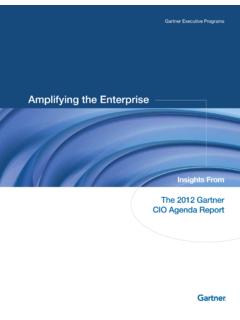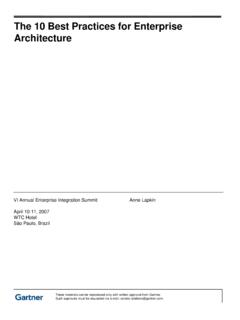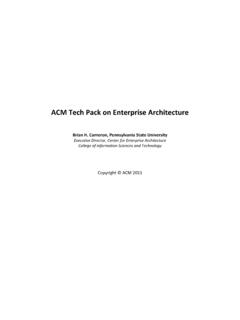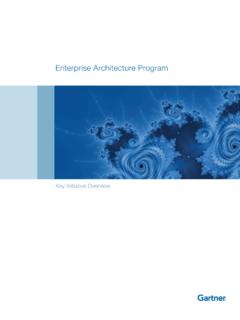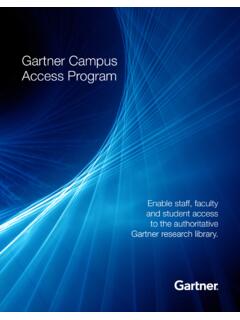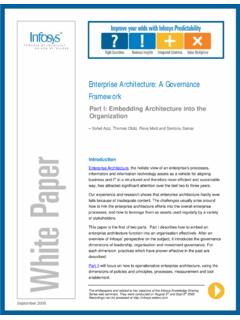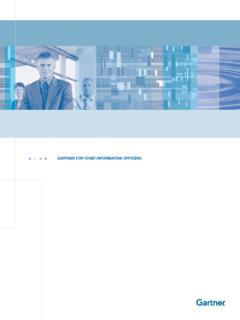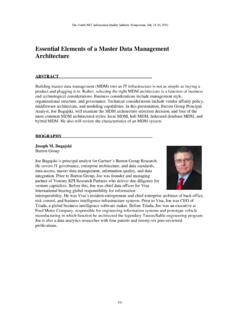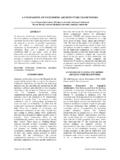Transcription of Enterprise Architecture Charter Unleash the …
1 4/22/2011 UNIVERSITY Enterprise Architecture Charter OF M ICHIGAN Unleash THE INNOVATION Version Enterprise Architecture Contents Executive 2 Enterprise Architecture Overview .. 2 3 Positioning .. 4 5 Design Reviews .. 7 Specific 7 Trends and Strategic Recommendations .. 7 Enterprise Architecture principles, directional statements, and standards .. 8 Benefits of Enterprise Architecture .. 9 Enterprise Architecture Philosophy at Michigan .. 10 Page 1 of 12 Enterprise Architecture Executive Summary In 2010, the University of Michigan undertook a multi year IT strategy called NextGen Michigan, with the objective of developing a world class 21st century information technology infrastructure in support of the academic, research, teaching, and learning missions of the University. The NextGen web site lists several high level objectives including: Propel innovation Manage technology investments with enhanced efficiency and effectiveness Focus on IT as a strategic/shared asset Deliver IT in new, less costly ways across campus One of the critical components of the NextGen initiative is a strategic technology roadmap that will help ensure that the overall IT direction and investment progresses in a common direction.
2 Enterprise Architecture (EA) is a discipline that collaborates with IT across campus to provide that strategic roadmap. Michigan's decentralized environment fosters a high degree of departmental innovation, but many times that innovation is trapped within the original environment and not exposed to the rest of the university. In those cases where innovation is spread to the rest of the university it is often through an inefficient ad hoc process. Via the IT roadmap, Enterprise Architecture is a guiding hand that both fosters innovation and provides a consistent methodology for the flow of that innovation from its origin point. At the same time, EA helps move technology commodities to a shared service so schools and departments can spend a greater percentage of their IT effort on mission specific projects and innovations. The net result is more innovation at the departmental level, and a stronger technology infrastructure at the central technology core.
3 Enterprise Architecture is a strategic capability that provides the University of Michigan with a common vision for information technology initiatives, trends and direction across all of its various communities. Enterprise Architecture Overview The University is a decentralized organization with many discrete Information Technology groups. These vary in size from 1 3 person departmental groups to a few groups with hundreds of staff (ITS, MCIT). Many groups believe in sharing innovative ideas, good practices, and processes. Given our numerous IT groups, University wide systems and supporting processes crafted specifically to support this sharing are needed. Today those systems and processes are insufficiently developed, or missing altogether and there is considerable friction in the organization that impairs this sharing. Page 2 of 12 Enterprise Architecture In the current IT environment: Schools and departments spend effort working on technology infrastructure and commodities effort that could be spent on mission specific items instead.
4 Innovations can remain trapped within departments and other departments may not even be aware that technology exists to solve a mission need. When departments implement new technology, they re invent the wheel because existing solutions are difficult to share, or groups lack awareness of what other units have done. There is not a good understanding of when a system should be implemented as a joint effort of several departments, and no standard procedure to follow when candidates for community projects are identified. When technologies become well enough adopted to be converted to a university wide service, initial solutions have often been implemented with a given technology, while a different technology may be needed to meet the new scale requirements. The original developer may have to choose between discarding their technology in order to use the common system or supporting their own now non standard version. IT organizations can create and deploy applications before the supporting infrastructure is sufficiently scaled, resulting in overloaded resources such as network or storage capacity.
5 The goal of Enterprise Architecture (EA) is to help minimize these disadvantages by providing a road map for technology, and enabling communication of that roadmap to all departments at the university. Scope The long term scope of the Enterprise Architecture group is intended to be all IT effort at the University of Michigan. EA's duty is to help manage the fundamental organization of the information technology embodied in its components, their relationships to each other and to the environment, and the principles guiding its design and evolution. Within this broad statement, EA's scope can be broken down into three major functions: Provide and communicate a technology road map to all interested parties. Recommend implementation strategies for specific technologies and products. Function as a conduit to move IT related information between the various IT departments at Michigan. Since Enterprise Architecture is new to the university, EA will begin with targeted projects and departments and then expand to include more IT effort over time as the EA process matures.
6 Page 3 of 12 Enterprise Architecture Positioning To describe the target position of the Enterprise Architecture it is helpful to reference two famous buildings. Biltmore House. Biltmore was built by Vanderbilt over a four year period in the 1890s. It is the top ranked non government building on the American Institute of Architects' List of America's Favorite Architecture . Biltmore was completely designed by Hunt and, since everything was architected before the groundbreaking began, all of the components of the building fit together in a beautiful and pleasing fashion. Winchester House. Winchester House was built by the heiress to the Winchester rifle fortune over a 38 . year period centered around 1900. There was no master building plan and the only rule was that construction take place 24 hours a day. According to their web site, it contains a window built into the floor, staircases leading to nowhere, doors that open onto blank walls.
7 EA's goal is to allow the flexibility of the Winchester House, but to provide a master plan so that when someone builds a doorway, there is another room waiting at the opening. We do not aspire to have everything architected before the building begins, as we believe that would limit the innovation which is a critical part of the Michigan mission and culture. Page 4 of 12 Enterprise Architecture Approach The process of maintaining and communicating a technology vision and roadmap can be distilled down to a small number of touch points with the rest of the technology community. These touch points are shown in the following diagram. Page 5 of 12 Wi de A do pti on Enterprise Architecture Na rr ow Design Reviews Ad op tio n Specific Recommendations Trends and strategic recommendations Page 6 of 12 Enterprise Architecture Design Reviews Every IT project campus wide will be asked to provide basic information about their project to the EA team.
8 If the project is deemed to be architecturally significant ( creates or uses Enterprise data or is of a certain scale in dollars), EA will offer a design review. Many projects will be purely departmental and will not require a review. But even for these projects that don't require a review, the knowledge of their basic details will help EA stay close to the pulse of emerging technologies, better identify when technologies that are thought to be unique are in fact being used in multiple projects, and help put the principals of those projects in touch with each other. Specific Recommendations Projects that receive a design review may receive recommendations based on the EA roadmap and the architectural standards. They may also receive feedback regarding the scope of the service, EA may recommend that several departments working on similar projects join them into a single community project. EA will also recommend technology building blocks that already exist elsewhere that can be leveraged for the project.
9 The entire IT community will also be periodically informed of emerging trends, shared and community projects that are being planned or underway, and existing services that are beginning to be phased out. Trends and Strategic Recommendations On a regular basis, the Enterprise Architecture group will collaborate with informed parties to gather up to date information and publish updates to its main artifacts. EA will present these new artifacts, with a summary of the changes in them, to all interested parties. The main artifacts maintained by the EA group are: o Recommended shared services. One of the most important benefits of EA is the ability to recommend when services should formally move down the service level pyramid. Services moving into the bottom tiers are often campus wide and are good candidates for ITS projects, which can provide project management and coordination. These technologies tend to already be pretty well established, have been known to the Architecture community for some time, and have already been incorporated into the relevant architectures.
10 Ideally, the architectural risk for these technologies has already been mitigated higher in the pyramid. The real opportunity for EA to provide architectural direction comes when a technology is just emerging from the departmental to the community level. This is the time when the campus wide view of EA can help combine several projects from several departments into a single community project. Community projects benefit from the ability to leverage resources, involve departments who would like the service but weren't able/willing to create it on their own, and increases the Page 7 of 12 Enterprise Architecture likelihood that the specific technology chosen will be able to be incorporated into a university wide service if it gets that low on the pyramid. EA will periodically look at the inventory of existing services and services that have been proposed or are underway and make a list of those services that should be implemented with some level of departmental sharing.
